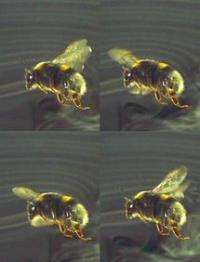Bumblebee flight 'triumph of power over finesse'

(PhysOrg.com) -- Brute force rather than aerodynamic efficiency is the key to bumblebee flight, Oxford University scientists have discovered.
In recent years scientists have modelled how insect wings interact with the air around them to generate lift by using computational models that are relatively simple, often simplifying the motion or shape of the wings.
‘We decided to go back to the insect itself and use smoke, a wind tunnel and high-speed cameras to observe in detail how real bumblebee wings work in free flight,’ said Dr Richard Bomphrey of the Department of Zoology, co-author of a report of the research published this month in Experiments in Fluids. ‘We found that bumblebee flight is surprisingly inefficient - aerodynamically-speaking it’s as if the insect is ‘split in half’ as not only do its left and right wings flap independently but the airflow around them never joins up to help it slip through the air more easily.’
Such an extreme aerodynamic separation between left and right sets the bumblebee [Bombus terrestris] apart from most other flying animals.
‘Our observations show that, instead of the aerodynamic finesse found in most other insects, bumblebees have a adopted a brute force approach powered by a huge thorax and fuelled by energy-rich nectar,’ said Dr Bomphrey. ‘This approach may be due to its particularly wide body shape, or it could have evolved to make bumblebees more manoeuvrable in the air at the cost of a less efficient flying style.’
Professor Adrian Thomas of Oxford’s Department of Zoology, co-author of the report, said: ‘a bumblebee is a tanker-truck, its job is to transport nectar and pollen back to the hive. Efficiency is unlikely to be important for that way of life.’
Observing insects in free - as opposed to tethered - flight is a considerable challenge. The Oxford team trained bumblebees to commute from their hive to harvest pollen from cut flowers at one end of a wind tunnel. They then used the wind tunnel to blow streams of smoke passed the flying bees, to reveal vortices in the air, and recorded the results with high-speed cameras taking up to 2000 images per second. From these images the team were able to visualise the airflow over flapping bumblebee wings.
The old myth that ‘bumblebees shouldn’t be able to fly’ was based on calculations using the aerodynamic theory of 1918-19, just 15 years after the Wright brothers made the first powered flight. These early theories suggested that bumblebee wings were too small to create sufficient lift but since then scientists have made huge advances in understanding aerodynamics and how different kinds of airflow can generate lift.
Provided by Oxford University (news : web)

















